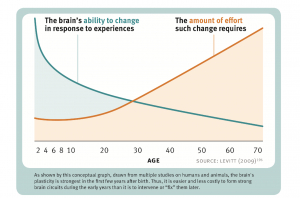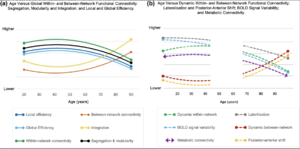Neuroplasticity

Neuroplasticity is the ability of the brain to change its default activity by modifying its own connectivity. It is an important evolved feature as it enables the brain to rewrite its software as unforeseen circumstances arise. As we age we this ability unfortnately degrades, however it has been found that psychedelics can temporarily reopen the neuroplastic window.

When young, humans are extremely neuroplastic (see Figure 1) meaning when an experience demands, it doesn't take much effort to change the brains default behaviour. Neuroplasticity declines as we age[1][3], leading to a more fused brain (see Figure 2)[2]. Recent studies have shown neuroplasticity can be temporarily improved by inducing pivotal mental states.
This decline in neuroplasticity was eloquently described in three points by Douglas Adams reflecting on our relationship with technology:
- Anything that is in the world when you are born is normal and ordinary and is just a natural part of the way the world works.
- Anything that is invented between when you are fifteen and thirty-five is new and exciting and revolutionary and you can probably get a career in it.
- Anything invented after you are thirty-five is against the natural order of things.
Structure-Activity
The brain is neurochemical in nature, meaning it is part electric and part chemical. When these systems combine to provide brain function they work like hiking trails; the pathways that get a lot of traffic get smoother and wider, with brush stomped down and pushed back. The neural pathways that sit unused grow over, becoming less likely to be used. Your brain uses the more accessible pathways as it takes lower energy to do so.
References
- ↑ 1.0 1.1 Changes in plasticity across the lifespan: Cause of disease and target for intervention. Publish 10 April 2015, accessed on 3rd March 2022, via https://www.ncbi.nlm.nih.gov/pmc/articles/PMC4392917/. Read an AI summary.
- ↑ 2.0 2.1 The older adult brain is less modular, more integrated, and less efficient at rest: A systematic review of large-scale resting-state functional brain networks in aging. Hamish A. Deery,Robert Di Paolo,Chris Moran,Gary F. Egan,Sharna D. Jamadar First published: 15 September 2022 https://doi.org/10.1111/psyp.14159. Accessed on 4th October 2022 via https://onlinelibrary.wiley.com/doi/10.1111/psyp.14159
- ↑ Molecular aging of the brain, neuroplasticity, and vulnerability to depression and other brain-related disorders. Dialogues in Clinical Neuroscience. Volume 15, 2013 - Issue 1. Etienne Sibille Pages 53-65 | Published online: 01 Apr 2022. Accessed 19th Jun 2022 via https://www.tandfonline.com/doi/full/10.31887/DCNS.2013.15.1/esibille